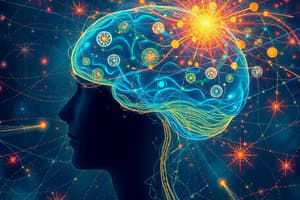Podcast
Questions and Answers
What is the primary focus of cognitive psychology?
What is the primary focus of cognitive psychology?
- Social interactions and cultural influences
- Observable behaviors and environmental stimuli
- Mental processes such as perception and memory (correct)
- Physiological responses to stimuli
Which psychological approach emphasizes observable behaviors rather than mental processes?
Which psychological approach emphasizes observable behaviors rather than mental processes?
- Cognitive psychology
- Psychoanalysis
- Humanistic psychology
- Behaviorism (correct)
Who is known as the 'father of cognitive psychology'?
Who is known as the 'father of cognitive psychology'?
- Hermann Ebbinghaus
- Ulric Neisser (correct)
- Jean Piaget
- Wilhelm Wundt
What type of research during the 1940s–1950s contributed to the cognitive revolution?
What type of research during the 1940s–1950s contributed to the cognitive revolution?
Which technique is commonly used in cognitive neuroscience to study brain activity?
Which technique is commonly used in cognitive neuroscience to study brain activity?
According to cognitive psychology, which of the following is NOT a focus area?
According to cognitive psychology, which of the following is NOT a focus area?
Which of the following statements best characterizes the role of synapses in neuron communication?
Which of the following statements best characterizes the role of synapses in neuron communication?
What did Hermann Ebbinghaus primarily study in cognitive psychology?
What did Hermann Ebbinghaus primarily study in cognitive psychology?
Which theory suggests that categories are formed around an average or ideal representation?
Which theory suggests that categories are formed around an average or ideal representation?
What evidence supports the similarity between perception and imagery?
What evidence supports the similarity between perception and imagery?
What is a limitation of the Definitional Theory in categorization?
What is a limitation of the Definitional Theory in categorization?
Which of the following levels of categorization is the most specific?
Which of the following levels of categorization is the most specific?
How does the Typicality Effect manifest in categorization?
How does the Typicality Effect manifest in categorization?
Which approach in semantic networks represents concepts as nodes with relationships as links?
Which approach in semantic networks represents concepts as nodes with relationships as links?
What is the primary feature of the Template Theory in categorization?
What is the primary feature of the Template Theory in categorization?
Which task demonstrates spatial processing of imagery?
Which task demonstrates spatial processing of imagery?
What does localization refer to in the context of brain functions?
What does localization refer to in the context of brain functions?
Which method is primarily used to measure electrical brain activity?
Which method is primarily used to measure electrical brain activity?
What does the Self-Memory System Model suggest about how memories are formed?
What does the Self-Memory System Model suggest about how memories are formed?
Which principle explains the tendency to perceive complete forms by filling in gaps?
Which principle explains the tendency to perceive complete forms by filling in gaps?
What is echoed memory primarily associated with?
What is echoed memory primarily associated with?
Which type of memory involves conscious recall of personal experiences?
Which type of memory involves conscious recall of personal experiences?
What aspect of flashbulb memories is most frequently misunderstood?
What aspect of flashbulb memories is most frequently misunderstood?
In perception, what does bottom-up processing involve?
In perception, what does bottom-up processing involve?
Which statement best describes the concept of action affordances in perception?
Which statement best describes the concept of action affordances in perception?
Which disorder is primarily characterized by the progressive loss of memory due to neurodegeneration?
Which disorder is primarily characterized by the progressive loss of memory due to neurodegeneration?
What does dual-coding theory propose regarding memory retention?
What does dual-coding theory propose regarding memory retention?
What does the Stroop Effect illustrate about cognitive processing?
What does the Stroop Effect illustrate about cognitive processing?
Which of the following statements about mirror neurons is true?
Which of the following statements about mirror neurons is true?
Which memory technique involves associating items with physical locations?
Which memory technique involves associating items with physical locations?
What characteristic is typical of procedural memory?
What characteristic is typical of procedural memory?
Which type of amnesia specifically involves the inability to form new memories after its onset?
Which type of amnesia specifically involves the inability to form new memories after its onset?
What is the primary function of the visuospatial sketchpad?
What is the primary function of the visuospatial sketchpad?
Which mechanism is NOT commonly used for transferring information from short-term memory to long-term memory?
Which mechanism is NOT commonly used for transferring information from short-term memory to long-term memory?
What effect does deep processing have on memory retention?
What effect does deep processing have on memory retention?
What is the testing effect in relation to memory retention?
What is the testing effect in relation to memory retention?
Which of the following best describes the levels of processing theory?
Which of the following best describes the levels of processing theory?
Which of the following statements about memory illusions is true?
Which of the following statements about memory illusions is true?
What principle explains the effectiveness of retrieval cues during memory recall?
What principle explains the effectiveness of retrieval cues during memory recall?
How does spaced practice enhance memory retention compared to massed practice?
How does spaced practice enhance memory retention compared to massed practice?
Which of the following best describes the role of the fusiform face area in the brain?
Which of the following best describes the role of the fusiform face area in the brain?
What does the Sapir-Whorf Hypothesis suggest about language?
What does the Sapir-Whorf Hypothesis suggest about language?
What is a common characteristic of Broca's Aphasia?
What is a common characteristic of Broca's Aphasia?
Which term best describes the smallest unit of meaning in a word?
Which term best describes the smallest unit of meaning in a word?
Which concept refers to the mental representations formed while reading a text?
Which concept refers to the mental representations formed while reading a text?
Flashcards
Localization
Localization
The idea that specific parts of the brain are responsible for certain functions.
Distributed Representation
Distributed Representation
Cognitive processes are spread across many brain regions, not just one.
EEG (Electroencephalography)
EEG (Electroencephalography)
Measures electrical brain activity to understand brain function.
fMRI (Functional Magnetic Resonance Imaging)
fMRI (Functional Magnetic Resonance Imaging)
Signup and view all the flashcards
TMS (Transcranial Magnetic Stimulation)
TMS (Transcranial Magnetic Stimulation)
Signup and view all the flashcards
Lesion Studies
Lesion Studies
Signup and view all the flashcards
Perception
Perception
Signup and view all the flashcards
Top-Down Processing
Top-Down Processing
Signup and view all the flashcards
Symbolic Imagery
Symbolic Imagery
Signup and view all the flashcards
Spatial Theory of Imagery
Spatial Theory of Imagery
Signup and view all the flashcards
Perception and Imagery Similarity
Perception and Imagery Similarity
Signup and view all the flashcards
Neuroscience of Imagery
Neuroscience of Imagery
Signup and view all the flashcards
Categorization
Categorization
Signup and view all the flashcards
Concept
Concept
Signup and view all the flashcards
Exemplar
Exemplar
Signup and view all the flashcards
Semantic Networks
Semantic Networks
Signup and view all the flashcards
Language
Language
Signup and view all the flashcards
Sapir-Whorf Hypothesis
Sapir-Whorf Hypothesis
Signup and view all the flashcards
Morpheme
Morpheme
Signup and view all the flashcards
What is cognitive psychology?
What is cognitive psychology?
Signup and view all the flashcards
What is behaviorism?
What is behaviorism?
Signup and view all the flashcards
Early 20th Century Psychology
Early 20th Century Psychology
Signup and view all the flashcards
What is the Cognitive Revolution?
What is the Cognitive Revolution?
Signup and view all the flashcards
What is Cognitive Neuroscience?
What is Cognitive Neuroscience?
Signup and view all the flashcards
What are Dendrites?
What are Dendrites?
Signup and view all the flashcards
What is the Cell Body (Soma)?
What is the Cell Body (Soma)?
Signup and view all the flashcards
What is an Axon?
What is an Axon?
Signup and view all the flashcards
Visuospatial Sketchpad
Visuospatial Sketchpad
Signup and view all the flashcards
Autobiographical Memory
Autobiographical Memory
Signup and view all the flashcards
Episodic Buffer
Episodic Buffer
Signup and view all the flashcards
Long-Term Memory
Long-Term Memory
Signup and view all the flashcards
Flashbulb Memories
Flashbulb Memories
Signup and view all the flashcards
Encoding
Encoding
Signup and view all the flashcards
Sensory Memory
Sensory Memory
Signup and view all the flashcards
Dual Coding Theory
Dual Coding Theory
Signup and view all the flashcards
Explicit Memory
Explicit Memory
Signup and view all the flashcards
Implicit Memory
Implicit Memory
Signup and view all the flashcards
Levels of Processing
Levels of Processing
Signup and view all the flashcards
Retrieval
Retrieval
Signup and view all the flashcards
Anterograde Amnesia
Anterograde Amnesia
Signup and view all the flashcards
Visual Imagery
Visual Imagery
Signup and view all the flashcards
Source Monitoring Problems
Source Monitoring Problems
Signup and view all the flashcards
Dual-Coding Theory
Dual-Coding Theory
Signup and view all the flashcards
Study Notes
Cognitive Psychology
- Cognitive psychology studies mental processes like perception, memory, language, problem-solving, reasoning, and decision-making. It examines how individuals understand, think, and learn by investigating internal processes which drive behavior and cognition.
- Behaviorism focuses solely on observable behaviors, ignoring internal mental processes. It emphasizes environmental stimuli and reinforcement. Pioneers include John Watson and B.F. Skinner.
- The cognitive revolution (1950s-1960s) challenged behaviorism, re-igniting interest in studying internal mental processes, thanks to advancements in artificial intelligence and linguistics.
- Key figures include Ulric Neisser, the "father of cognitive psychology," Hermann Ebbinghaus (memory and forgetting), Wilhelm Wundt (first psychology lab and introspection), Frederic Bartlett (reconstructive memory), and Jean Piaget (cognitive development in children).
- Cognitive neuroscience links cognitive psychology with neuroscience, exploring brain activity underlying mental processes. Techniques like fMRI and EEG are used to identify neural structures related to memory, language, and decision-making.
Neural Communication
- Neurons communicate via electrochemical signals. Action potentials travel along axons, and neurotransmitters transmit signals across synapses between neurons.
- Dendrites receive signals, the cell body (soma) processes them, and axons transmit them.
- Synapses are gaps between neurons; neurotransmitters facilitate communication across these gaps.
Cognitive Neuroscience Techniques
- EEG (Electroencephalography): Measures electrical brain activity.
- fMRI (Functional Magnetic Resonance Imaging): Tracks blood flow changes to infer brain activity.
- TMS (Transcranial Magnetic Stimulation): Disrupts specific brain regions to study their role.
- Lesion Studies: Examine behavioral changes following brain damage.
Perception
- Perception involves interpreting sensory information to understand the environment. It integrates bottom-up (sensory input) and top-down (existing knowledge) processing.
- Sensory stores (iconic and echoic memory) temporarily hold sensory information.
- Iconic memory is visual sensory memory lasting milliseconds. Echoic memory is auditory sensory memory lasting a few seconds.
Attention
- Attention focuses mental resources on specific stimuli while ignoring others. Includes selective, divided, and sustained attention.
- Dichotic listening tasks, visual search tasks, and various studies demonstrate how attention works.
Memory
- Memory is a complex system with processes like encoding, storage, and retrieval.
- Short-term memory (STM) temporarily holds limited information; working memory manages and manipulates information in STM.
- Long-term memory (LTM) stores vast amounts of information over time; its capacity is considered virtually unlimited. Types include implicit (unconscious) and explicit (conscious).
Memory Processes & Errors
- Factors like context, cues, and encoding affect memory retrieval.
- Encoding specificity principle shows that retrieval is most effective when cues match the initial encoding context.
- Memory illusions refer to false or distorted memories, often due to factors like misleading information, schemas, or source monitoring problems.
Memory Systems
- Explicit memory is conscious recall of facts and events (including episodic memory of personal experiences and semantic memory of general knowledge). Implicit memory is unconscious recall of skills and associations (including procedural memory and priming).
- Different memory systems play various roles in encoding, storage, and retrieval.
Memory & Forgetting
- The speed of forgetting varies depending on the kind of information to recall and external factors.
- Decay theory and interference theory explain different reasons for the forgetting process. Factors leading to memory illusions such as misleading information, pre-existing schemas, and errors in source monitoring can distort memories.
Memory Enhancing Techniques
- Spaced repetition, effective note-taking strategies, and context-dependent memory (recall/relearning done in similar environments) help to improve memory.
- Retrieval practice (frequent testing), contextual cues, and dual-coding theory (combining visual and verbal information) enhance memory encoding and retrieval.
Language
- Language is a system of words, symbols, and rules for communication; it involves phoneme, morpheme, syntax, and semantics.
- Language influences thought according to the Sapir-Whorf hypothesis. Broca's and Wernicke's areas are critical brain structures for language.
Imagery
- Visual imagery involves mentally representing visual information. Studies show the similarity between perception and imagery, as neural pathways and brain areas involved in both.
- Imagery can improve memory, problem solving, and planning by creating dual representations.
Studying That Suits You
Use AI to generate personalized quizzes and flashcards to suit your learning preferences.



